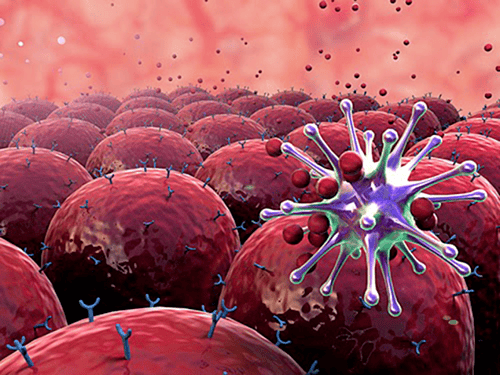This is an automatically translated article.
Article written by Master, Doctor Ha Thi Thu Hien - Pathologist - Laboratory Department - Vinmec Times City International Hospital
Global Cancer Organization Globocan said cervical cancer is one of the top 10 cancers with the highest incidence and mortality in Vietnam. On average, every year, the number of new cases of cervical cancer is 4,100 women and 2,400 women die. So how to treat cervical cancer to limit the complications of the disease?
1. Cervical cancer surgery
Many women with cervical cancer will have surgery. Surgery can be used to:
Help diagnose cervical cancer Help determine how far the cancer has spread Aids in cancer treatment (especially for early-stage cancer)
2. Cervical precancerous surgery
Two types of procedures can be used to treat cervical pre-cancer:
Destroy damaged tissue of the cervix with cold temperatures or with a laser, rather than removing it. Surgical removal and removal of precancerous cells. Cryotherapy
Cryotherapy is the use of a very cold metal probe that is placed directly into the cervix. This kills the abnormal cells by freezing them. It is used to treat cervical intraepithelial neoplasia (CIN). After cryotherapy, brown discharge may occur for a few weeks.
Using lasers
Laser ablation directs a focused laser beam through the vagina to burn off abnormal cells. The procedure is performed under local anesthesia or in the operating room with general anesthesia because it can be more uncomfortable than cryotherapy. It is also used to treat cervical intraepithelial neoplasia (CIN).

Cervical conical resection
Another way to treat cervical intraepithelial neoplasia (CIN) is surgical removal of the affected area, also known as a cone. The doctor removes a cone-shaped piece of tissue from the cervix. The tissue removed in the cone includes the transition zone where cervical precancer is most likely and where the cancer begins. Contouring of the cervix is not only used to diagnose pre-cancer and cancer. It can also be used as a treatment because it can sometimes get rid of cancers, pre-cancers, and some very early cancers completely.
This procedure can be done in different ways:
Using a surgical blade (Cold knife apex) Using a laser beam Using a thin electrically heated wire (LEEP or LEETZ) .
Trắc nghiệm về virus HPV
Hiện nay, những căn bệnh liên quan đến HPV ngày càng trở nên phổ biến và được cảnh báo nhiều hơn trên các phương tiện truyền thông. Hiểu đúng về HPV sẽ giúp bạn tránh được không ít nguy cơ dẫn đến ung thư các bộ phận sinh dục.
Bài dịch từ: webmd.com
3. Invasive cervical cancer surgery
The treatments for invasive cervical cancer are:
Hysterectomy (single or radical) Colectomy Hysterectomy alone
Hysterectomy alone removes the uterus (including the body of the uterus). uterus and cervix) but does not remove structures next to the uterus (cross ligaments and parametria). The vagina and pelvic lymph nodes were not removed. The ovaries are usually left intact unless there is another reason to have them removed.
Hysterectomy alone may be used to treat some types of severe CIN or some very early types of cervical cancer.
There are different ways to perform a hysterectomy:
Abdominal hysterectomy: The uterus is cut through an incision in the front of the abdomen. Vaginal hysterectomy: The uterus is removed through the vagina. Laparoscopic Hysterectomy : Laparoscopic Hysterectomy Robotic Assisted Surgery: In this method, the laparoscopic procedure is performed with special instruments attached to robotic arms by the doctor. Controls help to perform precise surgery. General anesthesia is used for all of these surgeries.
For laparoscopic or transvaginal hysterectomy, the hospital stay is usually 1 to 2 days, followed by a 2 to 3 week recovery period. A hospital stay of 3 to 5 days is common for an abdominal hysterectomy, and complete recovery takes about 4 to 6 weeks.

Possible side effects: Any form of uterine surgery leads to infertility (inability to have children). Complications can include bleeding, infection, or damage to the urinary system or intestines such as the bladder or colon.
Hysterectomy does not change a woman's ability to experience sexual pleasure. A woman does not need a uterus or cervix to achieve orgasm. The area around the clitoris and the lining of the vagina remains as sensitive as it was before the hysterectomy. You can find more information about managing the sexual side effects of cervical cancer treatment with a specialist
Radical hysterectomy
For this surgery, the hysterectomy uterus along with the tissues next to the uterus (uterine ligaments and parametria), the cervix, and the upper part of the vagina next to the cervix (2-3cm). More tissue is removed in a radical hysterectomy than in a hysterectomy alone, so the hospital stay may be longer. Some lymph nodes will also be removed and checked for cancer at this time.
This surgery is usually done through a large incision in the abdomen (also known as open surgery). Usually, some pelvic lymph nodes are also removed. (This method, called lymph node dissection)
Radical hysterectomy can also be performed laparoscopically or with robotic assistance. Laparoscopic (or robotic) surgery may result in less pain, less blood loss during surgery, and a shorter hospital stay than with open surgery. Having a radical hysterectomy through a cut in the abdomen is the preferred type of surgery in most cases. Laparoscopic surgery may still be an option for a specific subset of women with early-stage cancer, but surgery should be discussed with your doctor on a case-by-case basis. .
Possible side effects: Because the uterus is removed, this surgery leads to infertility. Because some of the nerves to the bladder are removed, some women have problems with urination after this surgery and may need a urinary catheter for a while. Complications can include bleeding, infection, or damage to the urinary system and intestines such as the bladder or colon.
The removal of some lymph nodes to check for cancer can sometimes lead to leg swelling. This is uncommon, but can happen after surgery and different treatments.
Radical hysterectomy does not change a woman's ability to experience sexual pleasure. Despite shrinking the vagina, the area around the clitoris and vaginal mucosa is still as sensitive as before. A woman does not need a uterus or cervix to achieve orgasm. When cancer has caused pain or bleeding during intercourse, a hysterectomy can actually improve a woman's sex life by stopping these symptoms.
Colectomy
Cervicalectomy, which allows women to receive treatment without losing the ability to have children. Surgery is done vaginally or through the abdomen, and is sometimes done laparoscopically. This procedure removes the cervix and upper part of the vagina but does not remove the body of the uterus. The surgeon will then place a permanent "purse-string" stitch inside the uterine cavity to keep the opening of the uterus closed the way a normal cervix would.

After a hysterectomy, some women are able to carry a full-term pregnancy and deliver a healthy baby by cesarean section, although women who have this surgery may have a higher risk of miscarriage.
Pelvic surgery
This surgery is done for very specific cases of recurrent cervical cancer. In this surgery, all the same organs and tissues are removed as in a radical hysterectomy with pelvic lymph node dissection. In addition, the bladder, vagina, rectum, and part of the colon are also removed, depending on where the cancer has spread.
Radiation therapy for cervical cancer
Radiation therapy is the use of high energy X-rays to kill cancer cells. Depending on the stage of cervical cancer, radiation therapy may be used:
As part of the main treatment. For some stages of cervical cancer, the preferred treatment is radiation therapy alone or surgery followed by radiation. For other stages, radiation and chemotherapy together (called concurrent chemotherapy) is the preferred treatment because chemotherapy helps the radiation work better. For the treatment of cervical cancer that has spread or recurred after treatment. Radiation therapy can be used to treat cervical cancer that has spread to other organs and tissues. Immediate side effects may include:
Fatigue (fatigue) Abdominal discomfort Diarrhea or loose stools (if radiation is given to the pelvis or abdomen) Nausea and vomiting Skin changes (mild red to flaking) flaking or peeling) Radiation cystitis: Radiation to the pelvis can irritate the bladder (radiation cystitis), discomfort, frequent urge to urinate, and sometimes blood in the urine . Vaginal pain: Radiation can make the vulva and vagina more sensitive and painful, and sometimes cause discharge. Menstrual changes: Pelvic radiation can affect the ovaries, leading to menstrual changes and even early menopause Low blood count: Anemia (low red blood cell count) can make you feel tired . Neutropenia (low white blood cell count) increases the risk of serious infections. Thrombocytopenia (low platelet count) increases the risk of bleeding. These side effects usually improve within a few weeks of stopping treatment.
Long-term side effects of radiation therapy
Women may experience radiation-related side effects months to years after treatment.
Vaginal stenosis: C can cause scar tissue to form in the vagina. Scar tissue can make the vagina narrower (called vaginal stenosis), less likely to last, or even shorter, which can make vaginal sex painful.
Vaginal dryness: Vaginal dryness and burning pain during sex can be a long-term side effect of radiation therapy. Estrogen used topically can help reduce vaginal dryness and changes in the vaginal lining, especially if pelvic radiation damages the ovaries and causes early menopause. These hormones are normally used in the vagina and are absorbed into the genital area, rather than taken orally. For more information, consult a specialist.

Rectal bleeding / rectal stricture : Rays distal to the rectal wall can cause chronic inflammation of this area which can lead to bleeding and sometimes rectal narrowing which can be painful. An abnormal opening (called a fistula) can also form between the rectum and the vagina, causing stool to exit the vagina. These problems usually occur in the first 3 years after radiation therapy. Additional treatments, such as surgery, may be needed to correct these complications.
Urinary problems: Radiation to the pelvis can cause chronic cystitis (as mentioned above), blood in the urine, or an abnormal hole between the bladder and vagina (called a fistula). ). These side effects can be seen many years after radiation therapy.
Weakened bones: Radiation to the pelvis can weaken bones, leading to fractures. Hip fractures are the most common and can occur 2 to 4 years after radiation therapy. Bone density should be checked to monitor fracture risk.
Leg swelling: If the pelvic lymph nodes are treated with radiation, it can lead to drainage problems in the legs. This can cause severe leg swelling, a condition called lymphedema.
If you are experiencing side effects from radiation treatment, talk to a specialist
Chemotherapy for cervical cancer
Chemotherapy uses anti-cancer drugs that are injected intravenously or orally . These drugs enter the bloodstream and can reach most areas of the body, and this treatment helps kill cancer cells in most parts of the body.
Not all women with cervical cancer need chemotherapy, but there are some cases where it should be:
Chemotherapy is part of the main treatment for cervical cancer
For In some stages of cervical cancer, the preferred treatment is radiation therapy and chemotherapy together (known as concurrent chemotherapy). Chemotherapy helps radiation work better. Options for concurrent chemotherapy include:
For cervical cancer that has spread or recurs after treatment
Chemotherapy may be used to treat cervical cancer that has spread to other areas other organs and tissues. It may also be helpful when cervical cancer recurs after chemotherapy and radiation treatment.
Chemotherapy drugs commonly used to treat cervical cancer that has recurred or spread to other areas include:
Cisplatin Carboplatin Paclitaxel (Taxol) Topotecan Which drug and combination of drugs to use? How this depends on the treating doctor and the specifics of each patient.

Side effects of chemotherapy for cervical cancer
Chemotherapy drugs kill cancer cells but also damage some normal cells, which can lead to certain side effects. Side effects depend on the type and dose of the drug and how long you have been treated. Many side effects are short-lived and go away after treatment ends, but some side effects can be long-lasting or even permanent. It's important to tell your doctor if you have any side effects, as there are often ways to ease them.
Common short-term side effects of chemotherapy may include:
Nausea and vomiting Loss of appetite Hair loss Mouth sores Fatigue Because chemotherapy can damage the blood-producing cells of the bone marrow, blood cell counts may become low. This can lead to:
Increased chance of infection due to a lack of white blood cells (known as neutropenia) Bleeding or bruising after minor cuts or injuries because of a lack of platelets in the blood (called is thrombocytopenia) Shortness of breath or fatigue due to a low red blood cell count (called anemia) When chemotherapy uses radiation, the side effects are usually more severe. Nausea, fatigue, diarrhea, and problems with low blood counts are often more severe.
Your treating doctor will monitor side effects and may give you medicines to help prevent them or treatment to help you feel better. For example, you may be given medicine to help prevent or reduce nausea and vomiting.
Long-term side effects of chemotherapy can include:
Menstrual changes: For young women who have not had a hysterectomy during treatment, menstrual changes are a common side effect of chemotherapy. treat. But even if your period stops while you're on chemotherapy, you can still get pregnant. It's not safe to get pregnant while injecting chemotherapy, as it can lead to birth defects and interfere with treatment. This is why perimenopausal women and women who are sexually active should discuss pregnancy control options with their treating doctor. Patients who have finished treatment can continue to have children, see a specialist.
Premature menopause and infertility are possible and possibly permanent. Some chemotherapy drugs are more likely to cause this than others. The older a woman gets when she gets chemotherapy, the more likely she is to experience infertility or menopause. If this happens, there is an increased risk of osteoporosis. There are medicines available that can treat or help prevent problems with osteoporosis.
Neuropathy: Some drugs used to treat cervical cancer, including paclitaxel and cisplatin, can damage nerves outside the brain and spinal cord. Trauma can sometimes lead to symptoms such as numbness, pain, burning or tingling sensations, sensitivity to cold or heat, or weakness, mainly in the hands and feet. This is called peripheral neuropathy. In most cases, the condition gets better or even goes away after treatment stops, but it can persist in some women.
Renal toxicity : Cisplatin, the main chemotherapy drug used to treat cervical cancer, can be nephrotoxic. Many times the damage is preventable and reversible, but sometimes the damage can be long-lasting. Usually, there are no symptoms, but lesions can be found on blood tests.
Other side effects may also occur. Some of these are more common with certain chemotherapy drugs. See your specialist to learn more about the possible side effects of the specific medications you are receiving.

4. Targeted therapy for cervical cancer
Researchers have learned more about changes in cancer cells, they have been able to develop drugs that target these changes. These targeted drugs work differently than standard chemotherapy drugs and often have different side effects.
Drugs that target angiogenesis
Vascular endothelial growth factor (VEGF) is a protein that helps tumors form new blood vessels to obtain nutrients needed for tumor growth. Certain targeted drugs called angiogenesis inhibitors block VEGF from working and stop the growth of this new blood vessel.
Bevacizumab (Avastin ® ) is an angiogenesis inhibitor that can be used to treat end-stage cervical cancer. It is a monoclonal antibody that targets VEGF.
This medicine is usually used with chemotherapy for a while. Then, if the cancer responds, chemotherapy can be stopped and bevacizumab given until the cancer starts to grow again.
Possible side effects of drugs that target VEGF
The possible side effects of this medicine are different from those of chemotherapy drugs. Some of the more common side effects may include:
High blood pressure Feeling tired Nausea Less common but more serious side effects may include:
Bleeding problems Blood clots Wound healing Heart failure or heart attack Immunotherapy for cervical cancer
Immunotherapy is the use of drugs to stimulate the person's own immune system to recognize and destroy cancer cells. cancer cells more effectively. Immunotherapy can be used to treat cervical cancer that has spread or has recurred.
Immune checkpoint inhibitors
An important part of the immune system is its ability to protect itself from attacking normal cells of the body. To do this, it uses "checkpoints" - molecules on immune cells that need to be turned on (or off) to initiate an immune response. Cancer cells sometimes use these checkpoints to avoid being attacked by the immune system. Newer drugs that target these checkpoints are being used as cancer treatments.
Pembrolizumab (Keytruda) targets PD-1, a protein on cells of the immune system called T cells that normally help keep these cells from attacking other cells in the body. By blocking PD-1, these drugs enhance the immune response against cancer cells. This can shrink some tumors or slow their growth.
Pembrolizumab may be used for certain types of cervical cancer that have either started to recur after chemotherapy or have metastasized.

5. Possible side effects of immunotherapy
Side effects of immunotherapy drugs may include fatigue, fever, nausea, headache, skin rash, loss of appetite, constipation, joint/muscle pain, and diarrhea.
Other, less serious side effects. It can sometimes cause serious or even life-threatening problems in the lungs, intestines, liver, hormone-producing glands, kidneys, or other organs.
During the treatment, if you have any side effects, please inform your doctor. If you experience serious side effects, it may be necessary to stop treatment or substitute another medicine
Cervical cancer in pregnancy
A small number of cervical cancers are found in pregnant women. Most of these (70%) are stage I cancers. The treatment plan during pregnancy depends on the specific and individual stage, the stage of the cancer and is decided by the specialist. Department
Vinmec International General Hospital is a prestigious address in the treatment of gynecological diseases in general. When performing laparoscopic complete hysterectomy here, patients can experience the most advanced techniques such as:
Hybrid operating room of Vinmec Ha Long is the most modern operating room system in the world today. , integrated operating room and advanced imaging facilities (CT scan, MRI, ultrasound ...) to help reduce surgery time and bring the best surgical efficiency to the patient, minimizing surgery. Due to the high risk of nosocomial infections and complications during laparoscopic surgery, patients can have less trauma, recover quickly, leave very small scars and especially, the safety is very high compared to conventional open surgery. Full HD laparoscopic gynecological surgery system; C tissue cutter when the tumor is too large; There is a need to push the uterus for surgery; There are devices for suturing the vagina. Total laparoscopic hysterectomy is a difficult technique - requiring a physician with extensive experience and training in this technique. In anesthesia resuscitation, Vinmec adheres to anesthesia protocols, anesthesia safety guidelines, anesthesia checklists for 100% of surgeries in order to minimize incidents and unwanted effects.
Please dial HOTLINE for more information or register for an appointment HERE. Download MyVinmec app to make appointments faster and to manage your bookings easily.














